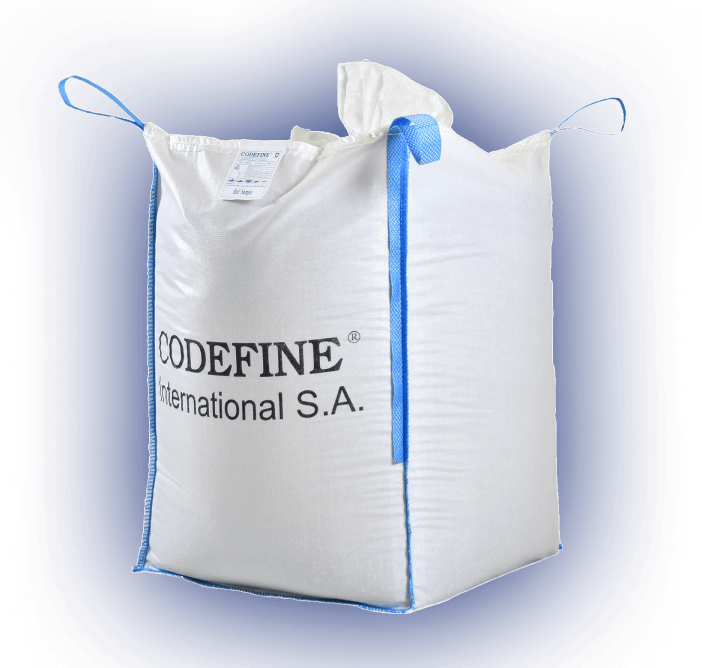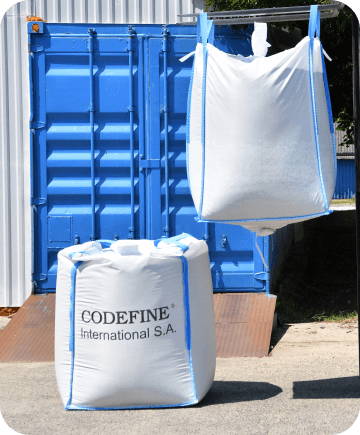Home » Posts Page » Blog » Products and Materials » FIBC Safety Factors: What They Mean and Why They Matter

In engineering terms, a safety factor represents the ratio between a container’s breaking strength and its safe working load (SWL). For FIBCs, this calculation determines how much stress the bag can withstand beyond its rated capacity before structural failure occurs. The industry has standardized these ratings into three primary categories: 5:1, 6:1, and 8:1.
A 5:1 safety factor indicates that the bag is designed to withstand five times its rated load capacity before failure. Similarly, 6:1 and 8:1 ratings offer progressively higher margins of safety. These ratings aren’t arbitrary; they’re determined through rigorous testing protocols and certified by authorized testing facilities that subject sample bags to controlled stress conditions.
Safety factor certification involves multiple test methods, including top lift testing, where bags are filled beyond their rated capacity until failure occurs. The resulting data establishes the maximum breaking strength, which is then used to calculate the safe working load by applying the appropriate safety factor ratio.
The development of FIBC safety standards has followed an evolutionary path driven by industrial incidents, technological advancements, and growing safety consciousness. Early bulk bags lacked standardized safety specifications, leading to inconsistent performance and occasional catastrophic failures.
Key regulatory bodies, including the International Organization for Standardization (ISO), the Flexible Intermediate Bulk Container Association (FIBCA), and various national standards organizations, have progressively refined safety requirements. ISO 21898, which specifically addresses FIBC construction and testing, has become the global benchmark for safety factor certification.
Current standards incorporate lessons learned from decades of industrial use across diverse environments. These regulations now encompass not only basic load-bearing capacity but also specialized requirements for hazardous materials, electrostatic properties, and environmental exposure resistance, creating a comprehensive safety framework for modern FIBC applications.
When evaluating FIBC safety factors, it’s essential to distinguish between several interconnected concepts that collectively determine a bag’s performance under load.
Safe Working Load (SWL) represents the maximum weight a bag can safely carry during normal use, while Breaking Strength indicates the ultimate load at which structural failure occurs. The ratio between these two values defines the safety factor. For instance, a bag with a 1,000 kg SWL and a 5:1 safety factor has been tested to withstand 5,000 kg before failure.
Static safety factors apply to stationary conditions where the bag remains motionless during filling, storage, or discharge. Dynamic safety factors, which are typically higher, account for additional stresses introduced during lifting, transportation, and handling. These dynamic forces can significantly impact a bag’s performance, especially in applications involving frequent movement or mechanical handling.
Application-specific considerations further refine safety factor selection. For instance, FIBCs containing hazardous materials require higher safety factors to minimize the risk of containment breach, while food-grade applications demand specific material properties in addition to appropriate safety margins.
The certification of FIBC safety factors relies on standardized testing methodologies that simulate real-world stresses in controlled environments. These tests evaluate various aspects of performance to ensure a comprehensive safety assessment.
Top lift testing represents the primary method for establishing safety factors. In this procedure, bags are suspended from their lifting loops and progressively loaded beyond their rated capacity until failure occurs. The resulting data determines the breaking strength and, consequently, the applicable safety factor.
UV resistance testing evaluates material degradation under prolonged sunlight exposure,a critical consideration for bags used or stored outdoors. Standardized tests expose bag materials to accelerated UV conditions, measuring strength retention over simulated time periods.
Impact and drop testing assess a bag’s ability to withstand sudden stresses during handling. These tests involve dropping filled bags from specified heights onto rigid surfaces, then examining them for structural integrity and containment performance. For certain applications, additional tests may include cyclic loading to simulate repeated use and vibration testing to evaluate performance during transportation.
|
Safety Factor Rating |
Maximum Safe Working Load |
Typical Applications |
Key Benefits |
Limitations |
|
5:1 |
Standard rated capacity |
General industrial use, non-hazardous materials |
Cost-effective, widely available |
Not suitable for hazardous materials |
|
6:1 |
Standard rated capacity |
Food products, pharmaceuticals, valuable materials |
Enhanced safety margin, meets higher compliance standards |
Higher cost, may require specialized manufacturing |
|
8:1 |
Standard rated capacity |
Hazardous materials, critical applications |
Maximum safety margin, highest regulatory compliance |
Premium pricing, specialized availability |
|
UN Certified |
Varies by certification |
Dangerous goods transport |
Meets international transport regulations |
Requires recertification and specific handling procedures |
|
Conductive/Type C |
Rated per safety factor |
Flammable materials, explosive environments |
Dissipates static electricity |
Requires grounding procedures, specialized design |
Choosing the appropriate FIBC safety factor requires balancing several considerations against specific industry requirements. This decision significantly impacts operational safety, regulatory compliance, and overall cost-effectiveness.
Industry-specific requirements often dictate minimum safety factors. Food and pharmaceutical applications typically demand 6:1 safety factors or higher, along with specific material certifications. Chemical industries frequently require specialized FIBCs with appropriate safety factors based on the hazard classification of contained materials. Construction and mining applications must consider both static loads and dynamic stresses introduced by mechanical handling equipment.
Risk assessment should drive safety factor selection beyond minimum requirements. This process evaluates factors like handling methods, environmental exposure, storage duration, and potential consequences of failure. Organizations should consider both the likelihood and the severity of potential incidents when determining appropriate safety margins.
Cost versus safety optimization represents a critical balance. While higher safety factors increase initial procurement costs, they may reduce long-term expenses related to incidents, regulatory non-compliance, or product loss. Progressive organizations view appropriate safety factor selection as an investment rather than merely a compliance cost.
Environmental conditions significantly influence FIBC performance and can compromise safety factors if not properly considered during selection and use.
Temperature extremes affect material properties and structural integrity. High temperatures can reduce tensile strength and accelerate aging, while extremely low temperatures may cause material embrittlement. FIBCs used in environments with wide temperature variations require appropriate safety factors to accommodate these stresses.
Moisture and humidity considerations are particularly relevant for hygroscopic materials or water-sensitive products. Prolonged exposure to humid conditions can degrade certain FIBC materials and compromise structural integrity. For applications in high-humidity environments, moisture barriers and enhanced safety factors may be necessary.
Chemical exposure presents specific challenges for FIBC safety. Even bags with appropriate safety factors can fail prematurely when exposed to incompatible chemicals. Manufacturers provide chemical resistance charts that should be consulted when selecting FIBCs for chemical storage or transport. In environments with aggressive chemical exposure, specialized materials and higher safety factors may be required to maintain performance over the intended service life.
Despite their critical importance, several misconceptions persist regarding FIBC safety factors, potentially leading to dangerous operational practices.
Overloading risks represent the most common misconception. Some operators incorrectly assume that safety factors provide a margin for occasional overloading. In reality, safety factors exist to accommodate unexpected stresses during normal use, not intentional overloading. Exceeding the rated capacity negates the safety factor and significantly increases failure risk, potentially resulting in catastrophic incidents, product loss, and workplace injuries.
Reuse considerations frequently lead to safety factor misunderstandings. Standard FIBCs are designed and tested for single-use applications, with safety factors calculated accordingly. Reusing single-use bags introduces unpredictable degradation that compromises the original safety factor. Organizations requiring multiple-use capabilities should specifically select FIBCs designed and certified for repeated use, with appropriate inspection protocols between cycles.
The importance of proper handling and training cannot be overstated. Even FIBCs with high safety factors can fail when improperly handled. Common handling errors include dragging rather than lifting, using unsuitable lifting equipment, or applying point loads to bag surfaces. Comprehensive training programs should emphasize proper handling techniques and the limitations of safety factors in real-world applications.
The evolution of FIBC safety continues with emerging technologies and approaches that promise enhanced performance and risk management capabilities.
Innovations in material science are expanding the possibilities for FIBC design. Advanced polymers with improved strength-to-weight ratios allow higher safety factors without corresponding weight increases. Self-healing materials that can automatically repair minor damage before it compromises structural integrity are under development. Additionally, materials with inherent antimicrobial properties address specialized requirements for food and pharmaceutical applications.
Smart monitoring and IoT integration represent the frontier of FIBC safety management. Load sensors embedded within lifting loops can provide real-time weight monitoring and overload warnings. RFID and similar technologies enable automated tracking of safety certification status and usage history. Environmental monitors can detect conditions that might compromise safety factors, such as chemical exposure or excessive temperature fluctuations.
The balance between sustainability and safety is driving innovation in recyclable and biodegradable FIBC designs that maintain appropriate safety factors. Manufacturers are developing materials that offer environmental benefits without compromising performance or safety. Additionally, reusable FIBC designs with reliable safety factors across multiple use cycles are reducing waste while maintaining operational safety.
At Codefine, we approach FIBC safety as a comprehensive system rather than isolated components. Our industrial packaging solutions are engineered with safety factors that exceed industry standards, ensuring reliable performance even under challenging conditions.
Codefine’s commitment to FIBC safety begins with material selection and extends through manufacturing processes to final quality control. Our testing protocols go beyond minimum requirements to verify that each product maintains its specified safety factor under real-world conditions. This attention to detail has established Codefine as a trusted partner for organizations where containment reliability is mission-critical.
At Codefine, we approach FIBC safety as a comprehensive system rather than isolated components. Our industrial packaging solutions are engineered with safety factors that exceed industry standards, ensuring reliable performance even under challenging conditions.
Codefine’s commitment to FIBC safety begins with material selection and extends through manufacturing processes to final quality control. Our testing protocols go beyond minimum requirements to verify that each product maintains its specified safety factor under real-world conditions. This attention to detail has established Codefine as a trusted partner for organizations where containment reliability is mission-critical.
Our industrial packaging systems complement traditional FIBCs by providing integrated solutions for the entire material handling workflow. We design our packaging products with a holistic view of industrial processes, ensuring compatibility between different container types and handling equipment. All Codefine products are engineered with consistent attention to safety factors, ensuring reliable performance under demanding industrial conditions.
The synergy between proper FIBC selection and Codefine’s comprehensive packaging solutions creates an integrated ecosystem that optimizes both safety and productivity. By extending safety considerations across the entire packaging lifecycle, organizations can significantly reduce workplace injuries and product loss while improving operational efficiency.
FIBC safety factors represent far more than technical specifications; they’re fundamental components of industrial risk management and operational safety. Understanding the meaning and importance of these ratings enables informed decision-making that balances safety requirements against practical and economic considerations.
As industrial applications continue to evolve, the significance of appropriate safety factor selection will only increase. Organizations that approach this topic with the seriousness it deserves will not only enhance workplace safety but also improve operational reliability and regulatory compliance.
For specialized guidance on selecting the appropriate FIBC safety factors for your specific applications, or to learn more about Codefine’s innovative industrial packaging solutions, from FIBCs to container liners, PP bags, jute produce bags, and woven PP packaging, contact our expert team today. Our experienced specialists can help you optimize your entire material handling workflow with safety and efficiency as primary considerations.
